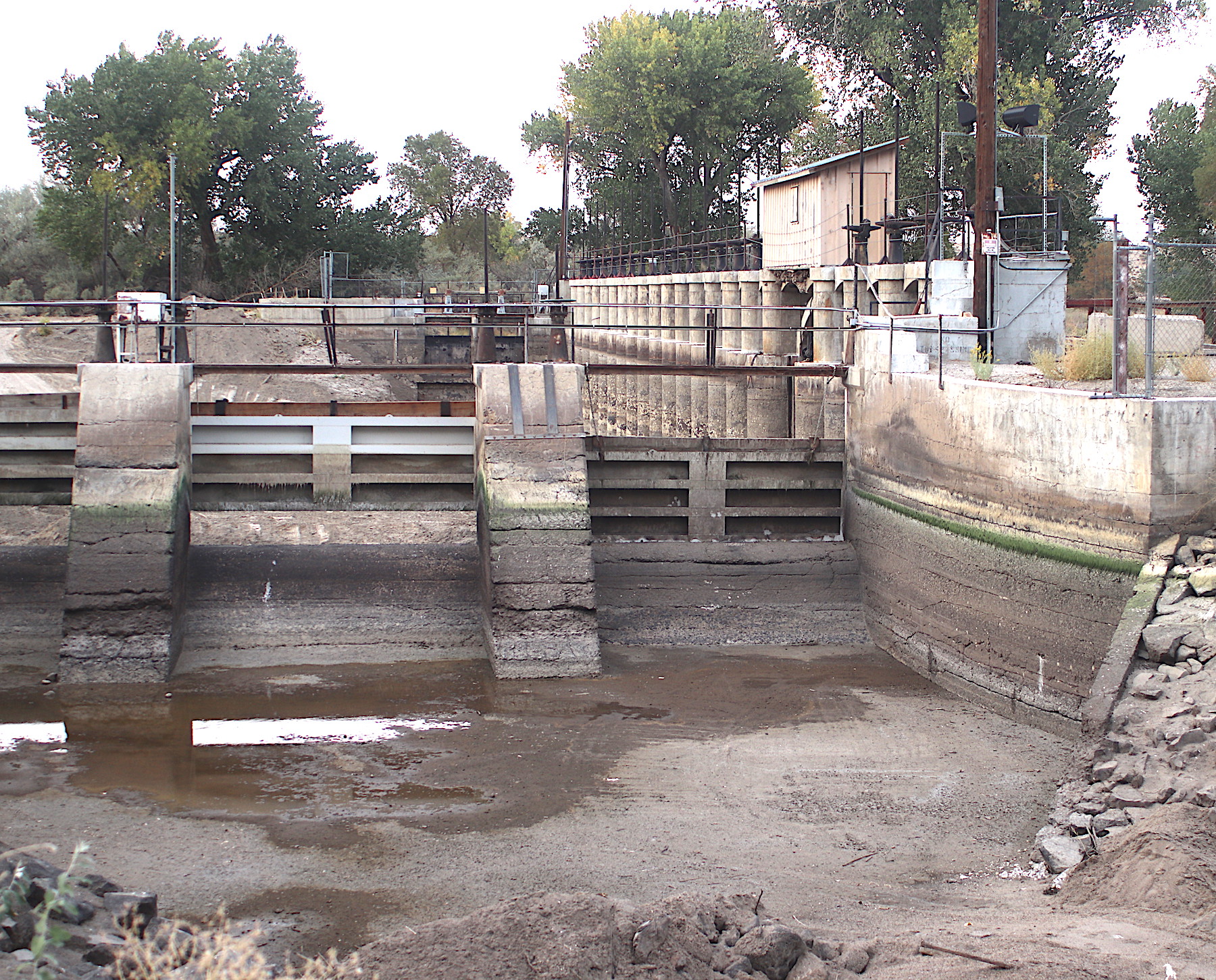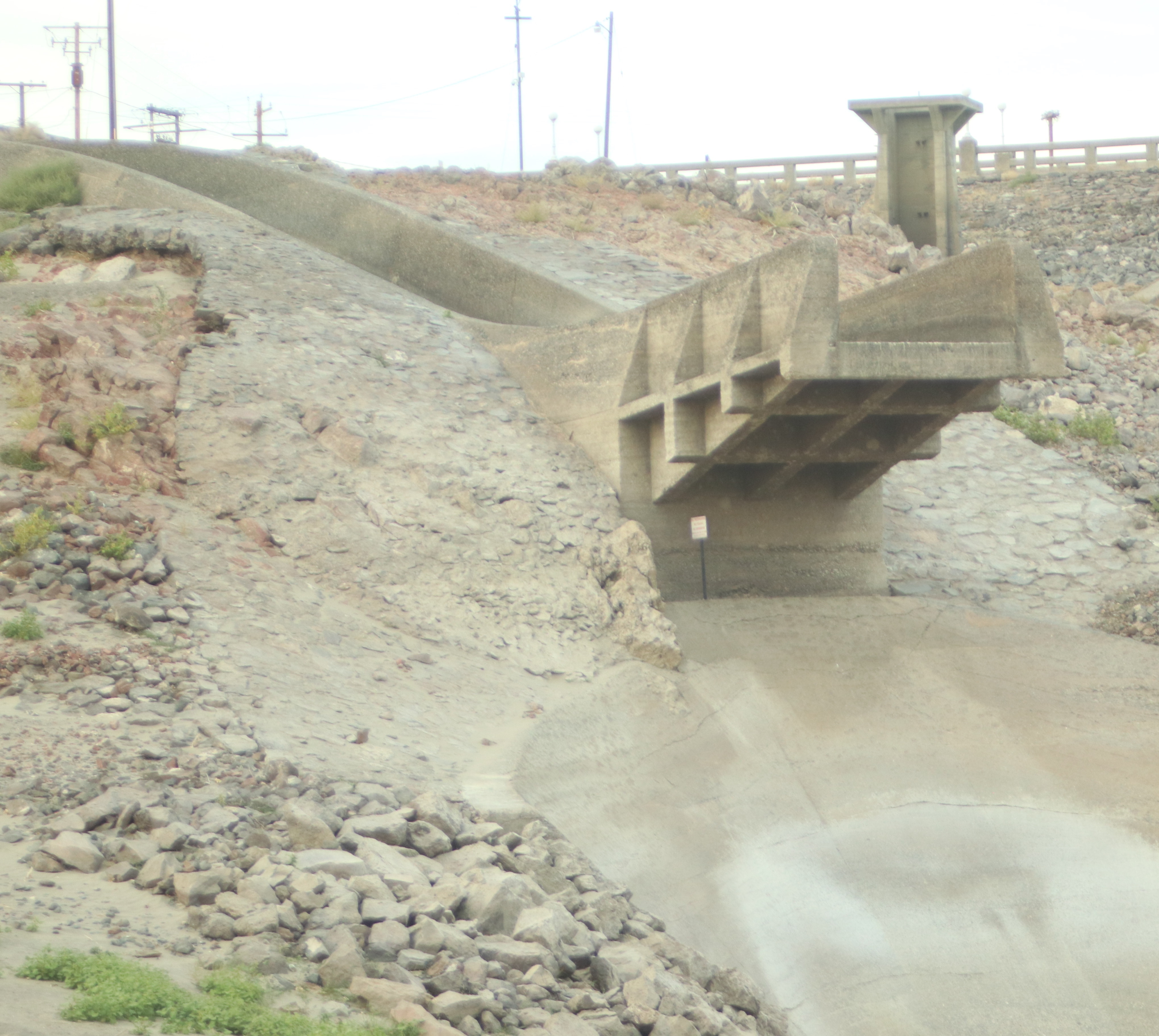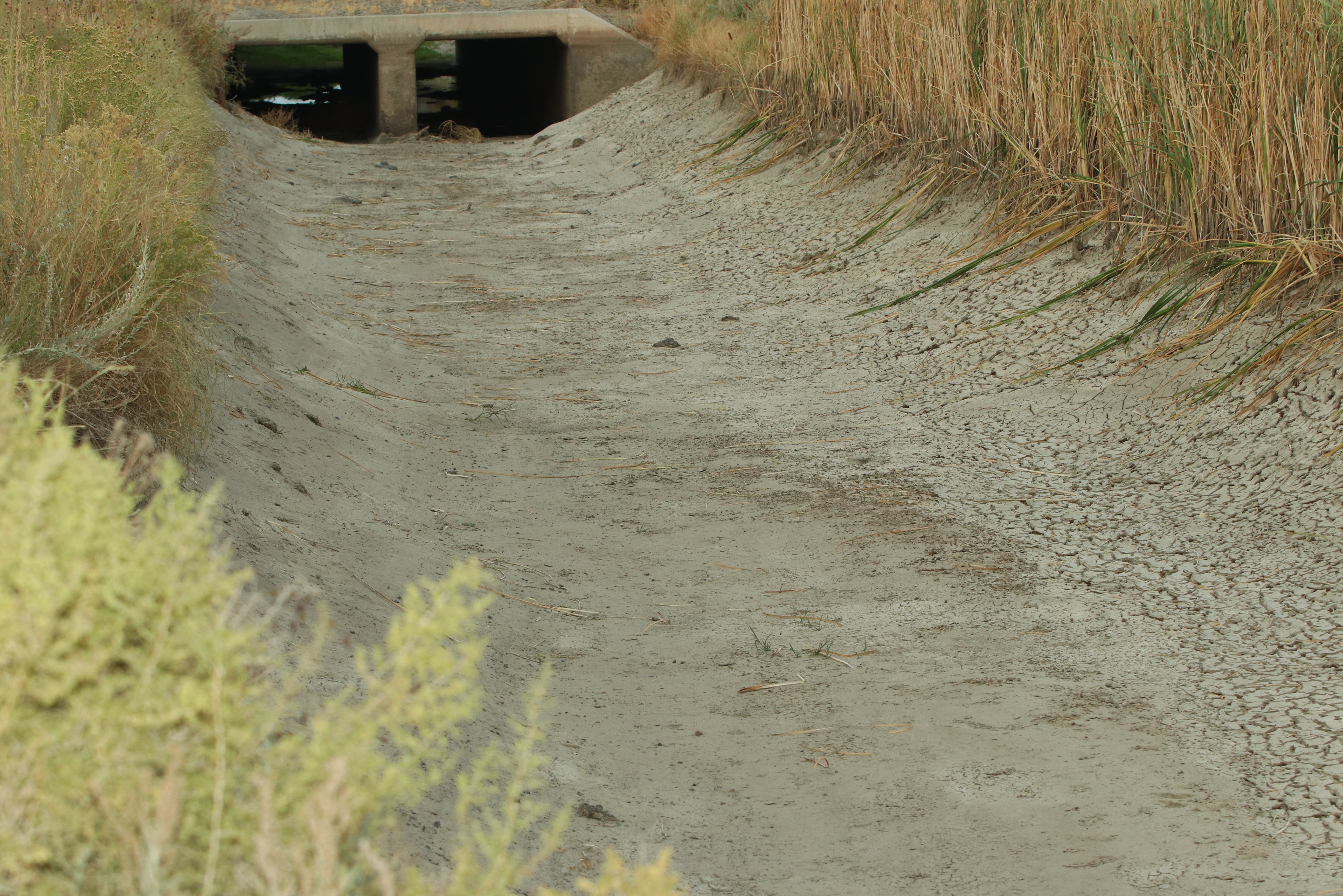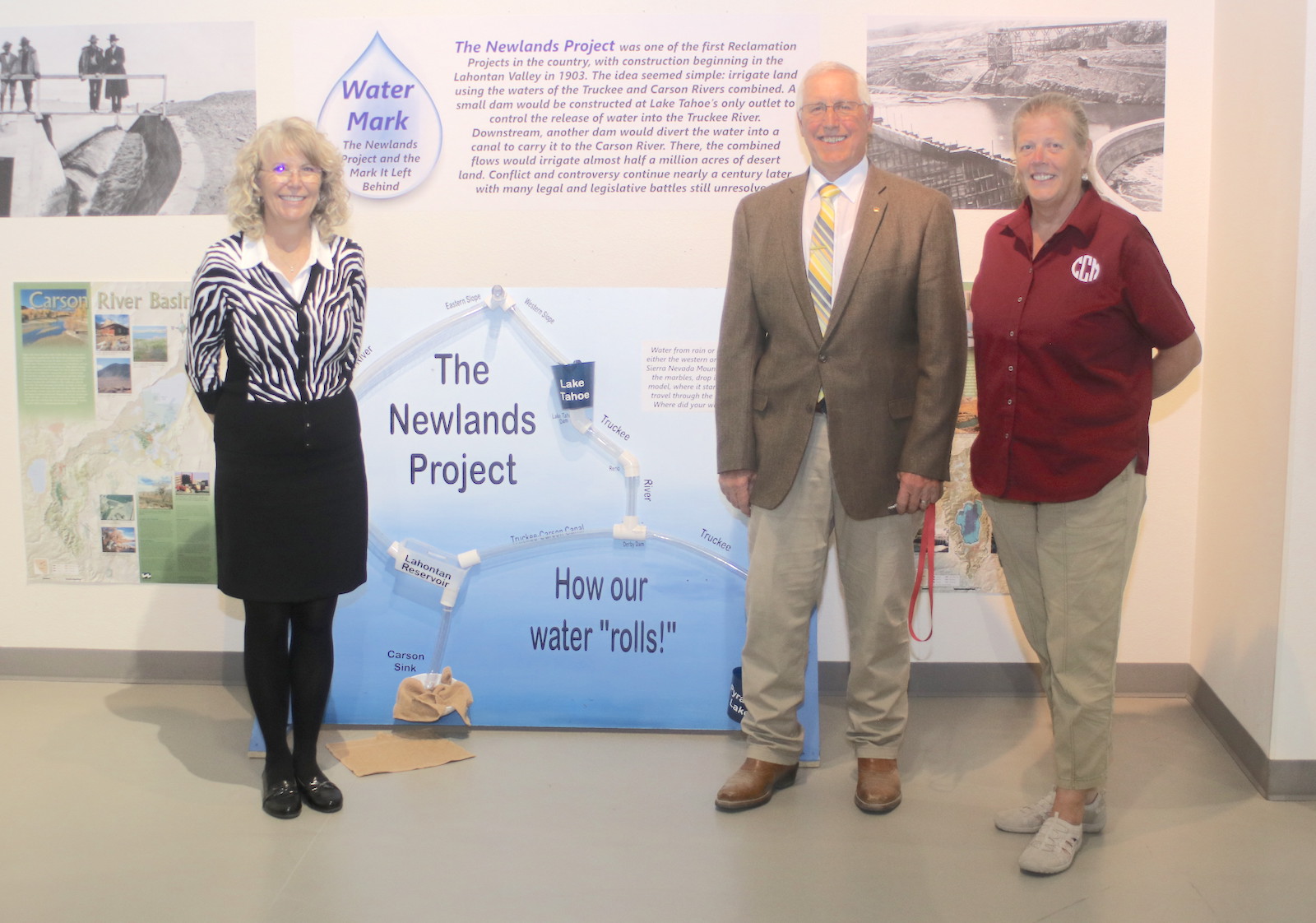In a good year, water flows from the Lahontan Reservoir via the dam to the Carson River.
A congressional act more than a century ago changed the Lahontan Valley from a desert to a blooming paradise for agriculture.
Ernie Schank, retired director of the Board for the Truckee-Carson Irrigation District, presented a history of the Newlands Project and how it transformed western Nevada. Schank’s talk was the second presentation from the Churchill County Museum’s seven-part lecture series on water.
Schank showed more than 100 photos on the Newlands Project from when the late Sen. Francis G. Newlands proposed the bill to his colleagues. The Churchill County native has become an expert in water issues over the years, beginning when he ran for the TCID board as a 28-year-old and stayed for four years. He ran again for the board in 1998 and was tabbed as the new president.
“I asked my father for advice,” Schank said, wondering if he should seek a position on the TCID board. Steve Ranson/LVN
Steve Ranson/LVN
The Diversion Dam, which channels water from the Carson River to the V-Line canal, is almost identical to Derby Dam on the Truckee River.
Cyril Schank who had served on the county commission, told his son being on the TCID was more important. Ernie Schank said his life has been enriched with water and agriculture and how it affects the valley. During his tenure on the board, Schank said he has become more knowledgeable of Congress and how both chambers act or don’t act on water issues.
Schank gave an overview of the Newlands Project’s infancy, primarily focusing on 1903-05 and what led up to the implementation. He said the project is now 118 years old, 15 years older than TCID. Lahontan Dam was not part of the early authorization. Newlands first served as a representative from 1893-1903 and then as a senator from 1903-17. Schank said Newlands envisioned a water project for western Nevada as far back as the early 1890s when he approached the Nevada Legislature as a congressman to float his irrigation project because the glory days of mining had been declining.
“He went to the Legislature with his maps and diagrams of reservoirs,” Schank explained. “He wanted the state to be the instigator for reclamation.”
Presenting before the Legislature did not go Newland’s way. Steve Ranson/LVN
Steve Ranson/LVN
The Truckee Canal ends with a chute extending over the north shore of Lahontan Reservoir.
“The state turned him down,” Schank added.
Newland’s plan wasn’t gaining any traction at the national level, especially with President William McKinley, who began his term on March 4, 1897. The two Republicans couldn’t see eye-to-eye on the importance of the reclamation project in the West.
“McKinley wasn’t interested in developing a project,” Schank said, despite the two men belonging to the same political party. Steve Ranson/LVN
Steve Ranson/LVN
The T-Line canal flows under U.S. Highway 50 neat Leeteville Junction.
An assassin’s bullet changed the project’s future when a gunman shot McKinley at a Pan-American Exposition in Buffalo, New York. Vice President Theodore Roosevelt succeeded McKinley, who died nine days after the attack.
“Roosevelt was a conservationist,” Schank pointed out, adding the new president wanted to see the reclamation projects advance.
Newland’s bill passed Congress, and Roosevelt signed it into law. The Truckee-Carson project, which became the Newlands Project in 1919 two years after the senator died, became the first to receive authorization for construction and the first to be dedicated.
“Newlands wanted this to be the poster child,” Schank said.
Newlands was a bigger-than-life character who loved spending his time in Washington, D.C. He graduated from George Washington University (formerly Columbian College) and was admitted to the bar at the age of 23. He later met William Sharon, an agent for the Bank of California who became rich as the bank reaped a fortune on the Comstock. Newlands fell in love with Clara Sharon, but she died in childbirth in 1882 trying to deliver the couple’s fourth child.
Newlands remarried in 1888 to Edith Hall McAlister, and they moved to Nevada from San Francisco.
In early 1903, the secretary of the Department of the Interior authorized the U.S. Reclamation Service (now the Bureau of Reclamation), to begin construction on five projects.
Construction first began Oct. 2, 1903, on the Derby Diversion Dam, which would channel water from the Truckee River toward the Lahontan area in a canal and provide water to Fernley and Hazen. At that time, the plan initially called for Lake Tahoe to serve as the main storage area during the spring. The spring runoff from the Sierra Nevada ran down the Carson River to feed the emerging farms, and when the water ran out, Schank said additional water was released from Lake Tahoe.
The Carson River provided at least 75% of the needed water for agriculture. Steve Ranson/LVN
Steve Ranson/LVN
Churchill County Museum Director Teri Hedgpeth, left, stands with Ernie Schank, the guest speaker who described the early years of the Newlands Project, and the museum’s education curator, Gretchen Felte.
Work crews finished the Derby Dam in less than two years, and construction of the Truckee Canal consisted of three phases. Derby Dam became the first, and Schank said four tunnels built over a seven-mile span between the dam to Fernley became the second phase. The shortest tunnel extended 50 yards, while tunnel 3 stretched along the mountainside for 1,515 feet. The final phase consisted of an 18-mile canal from the Fernley area to a chute near Lahontan.
“All the construction companies came from San Francisco,” Schank said. “It took a little less than two years to complete construction.”
Diversion Dam, which was a replica of Derby Dam, was built across the Carson River about 13 miles west of Fallon. Diversion Dam channels water to the V-Line canal that supplies about 75% of the water for agriculture. Shank said it’s easy to spot the differences between the two dams. He said cottonwood trees surround Diversion Dam.
A big celebration followed the completion of Derby Dam with a number of dignitaries taking the train to Derby Dam. Schank said dignitaries hailed from Washington, D.C., and locally. The guest listed included 14 congressman, eight senators, one governor and one lieutenant governor. The dedication was re-enacted in 2003.
Derby Dam was constructed on a natural bed and had nine canal gates and 18 river gates. Schank said the total cost to build Derby Dam was $85,390. Crews constructed two spillways and extended the chute on the Truckee Canal to drain into the Carson River. The original plans, though, failed to provide an ample supply of water.
“Storage at Lake Tahoe wasn’t working,” Schank said. “About $2 million was authorized to build a reservoir and dam.”
Construction finished in 1915 on the dam, which also generated hydropower.
Schank said the construction of Derby Dam and the other four projects paved the way for the construction of Hoover Dam south of Las Vegas. Almost 40 years after Congress approved the irrigation projects, the United States entered World War II after Japanese war planes bombed military installations and ships at Pearl Harbor on Dec. 7, 1941.
“Reclamation is the only reason we won the second world war,” Schank said. “The power was produced to make the war machine work.”MORE INFO
“Water Mark: The Newlands Project and the Mark It Left Behind” will run through Oct. 19 at the Churchill County Museum. All presentations are free and open to the public on Tuesdays beginning at 6 p.m. Teachers may receive professional development hours.
 Steve Ranson/LVN
Steve Ranson/LVN Steve Ranson/LVN
Steve Ranson/LVN Steve Ranson/LVN
Steve Ranson/LVN Steve Ranson/LVN
Steve Ranson/LVN